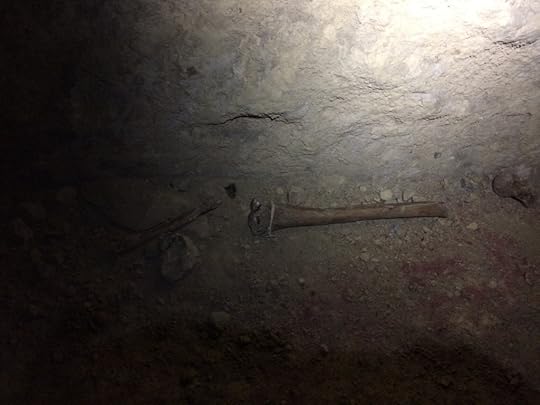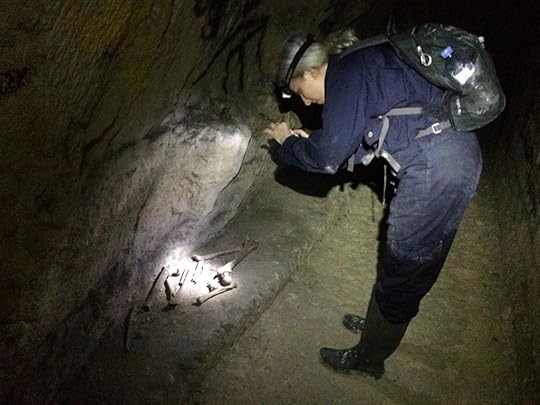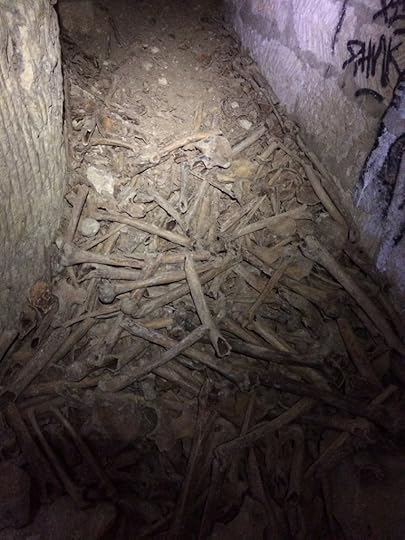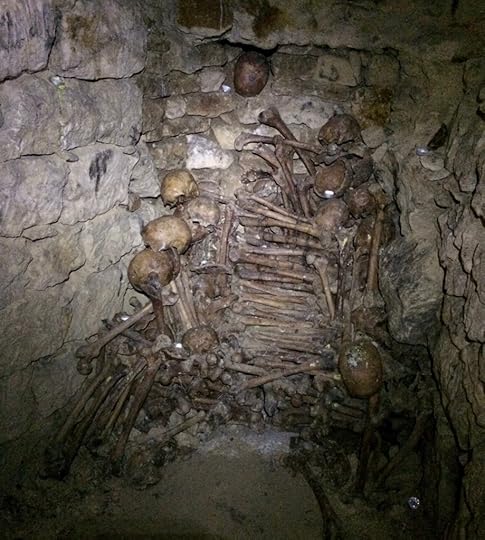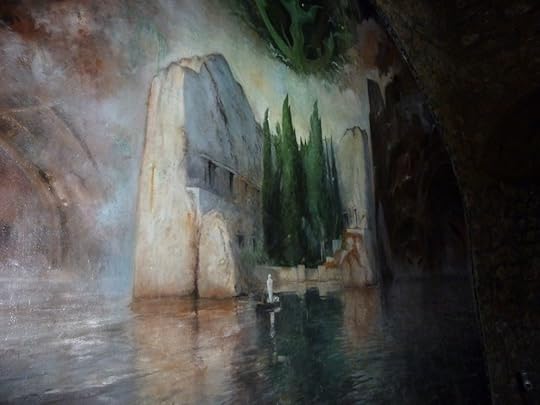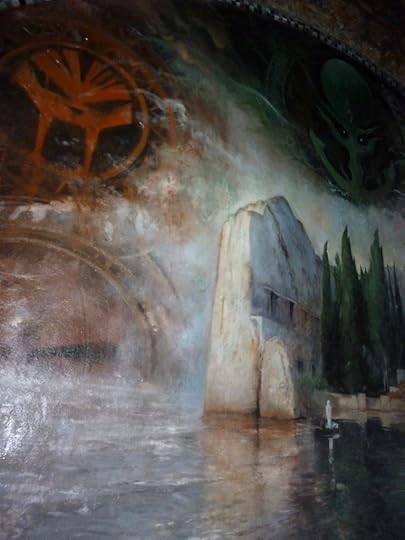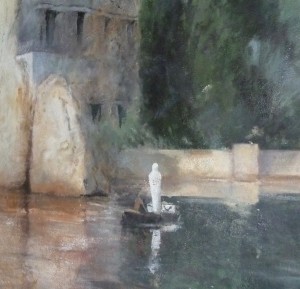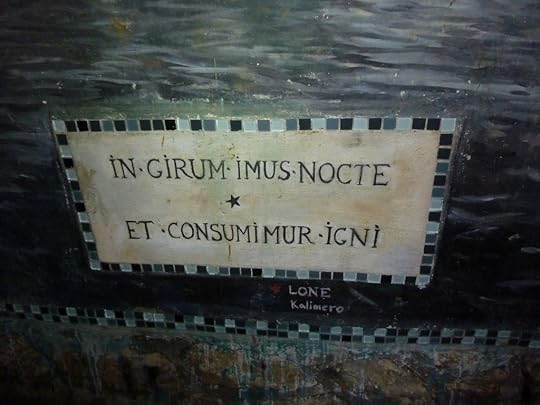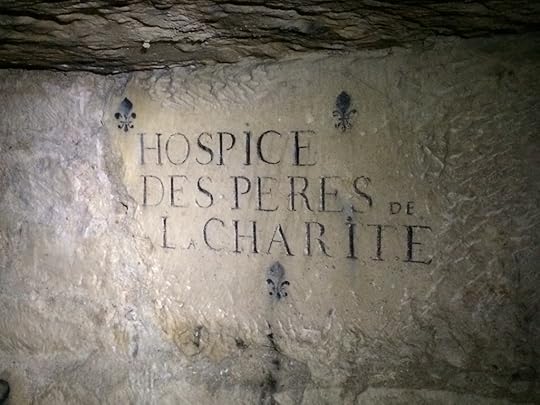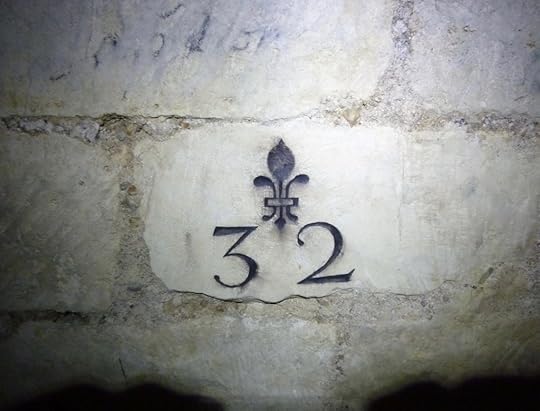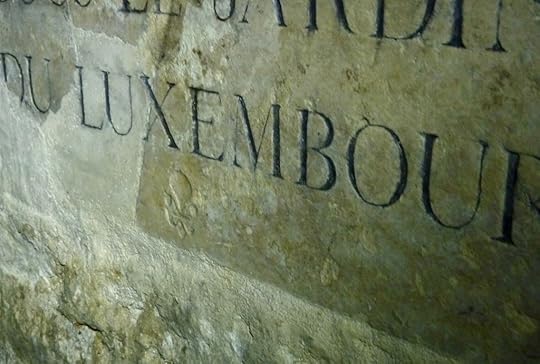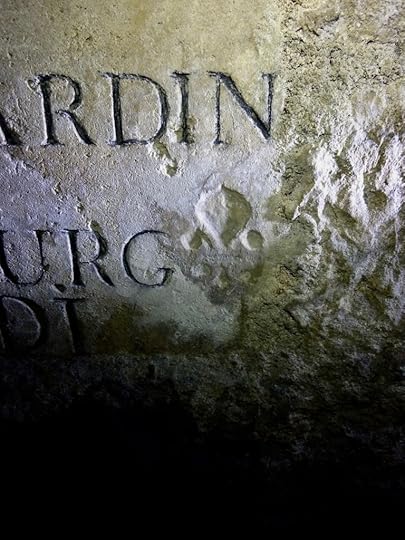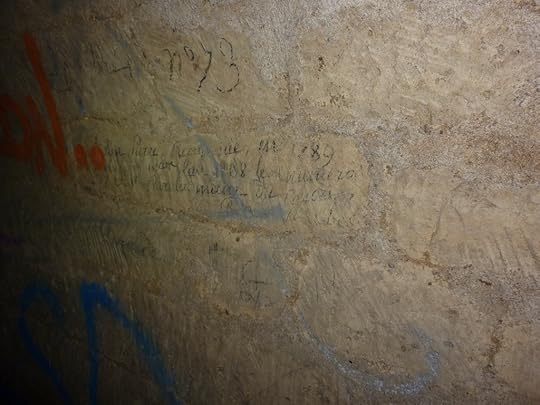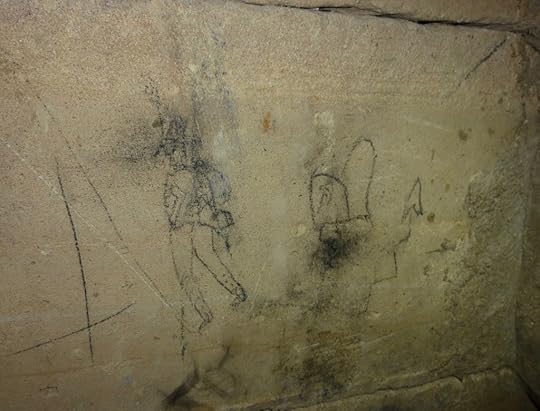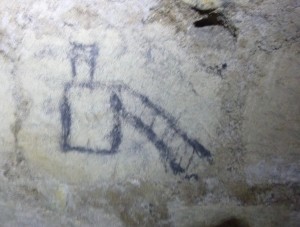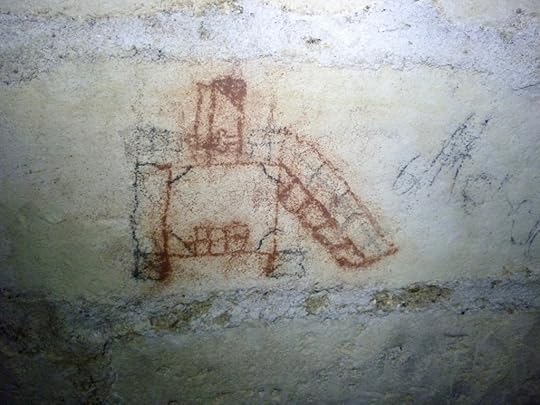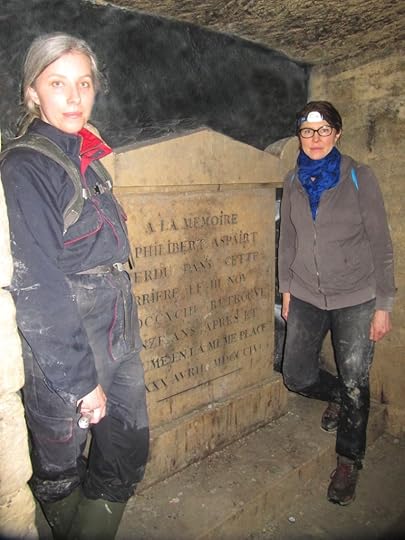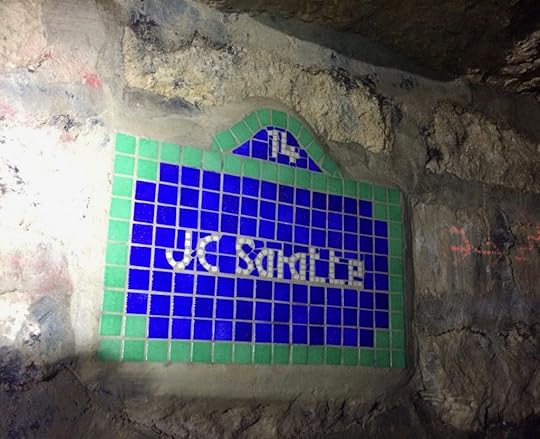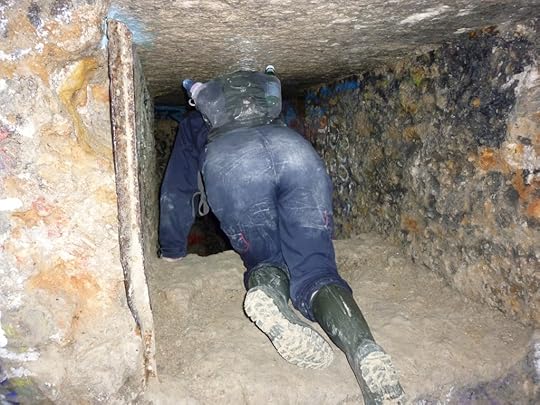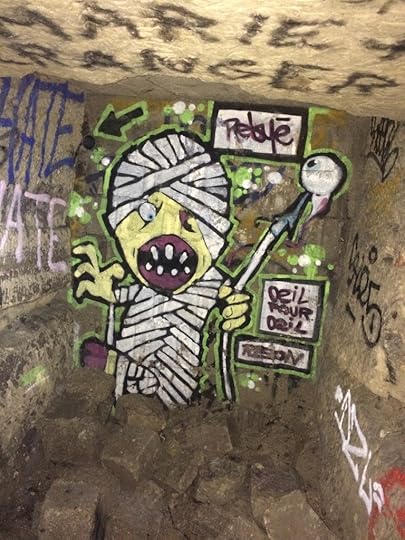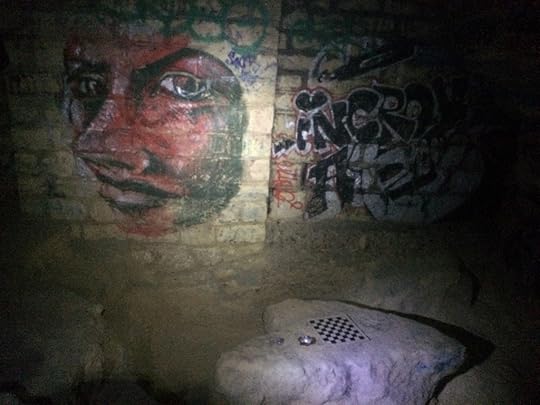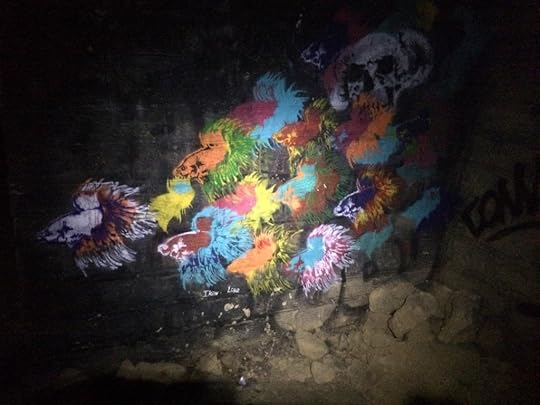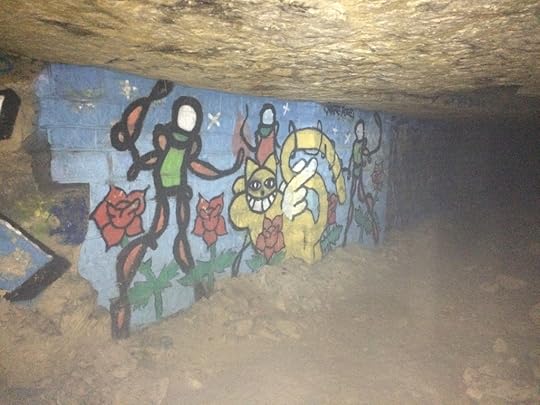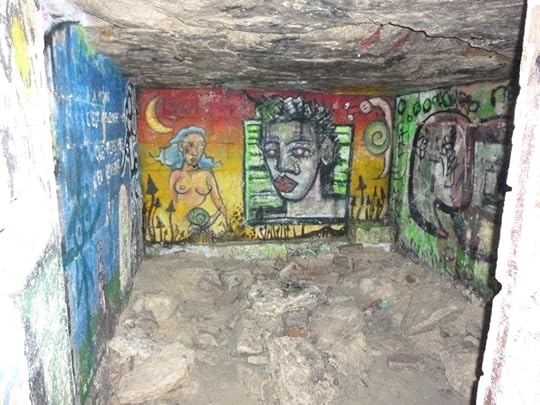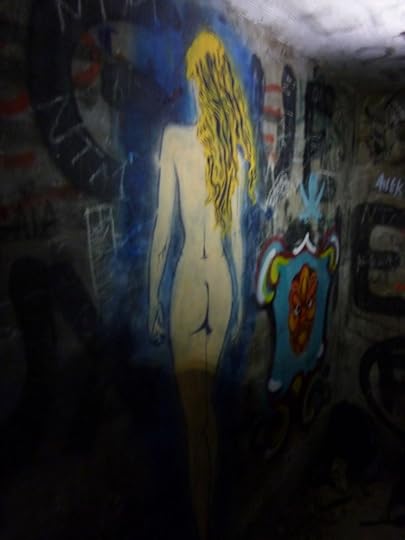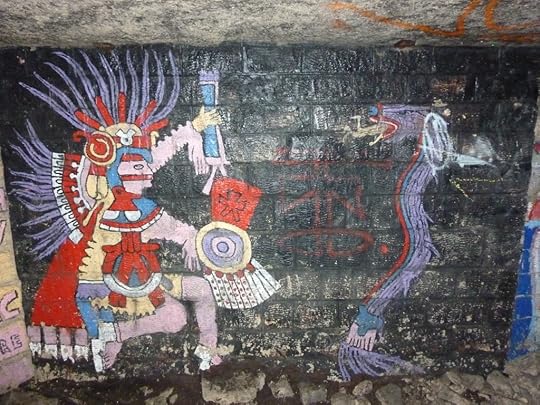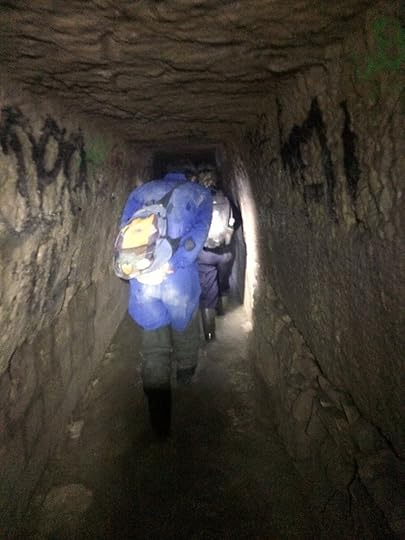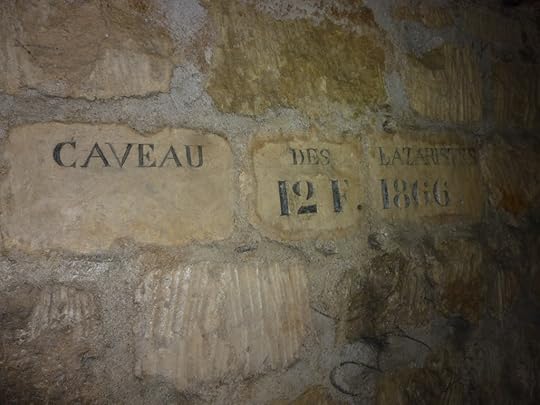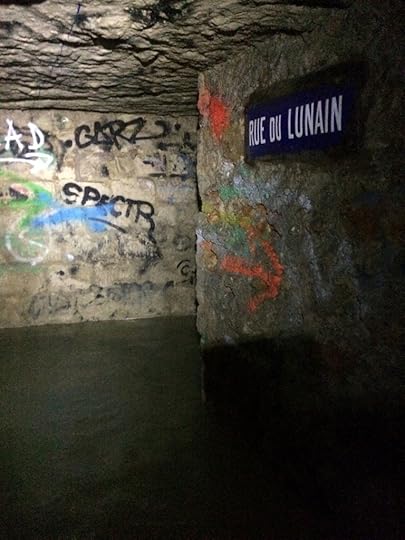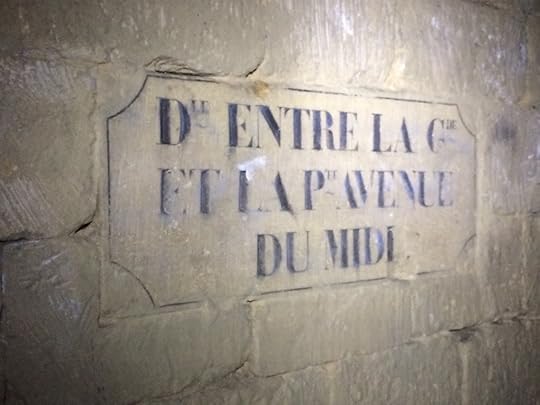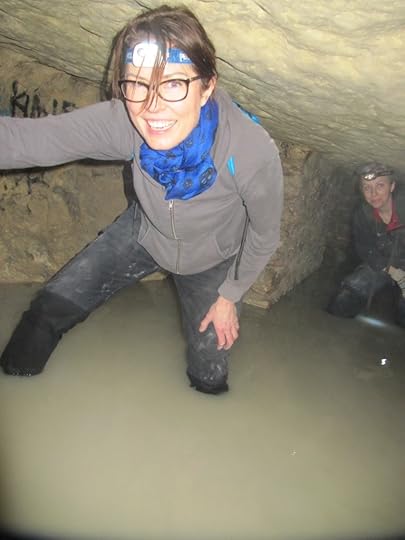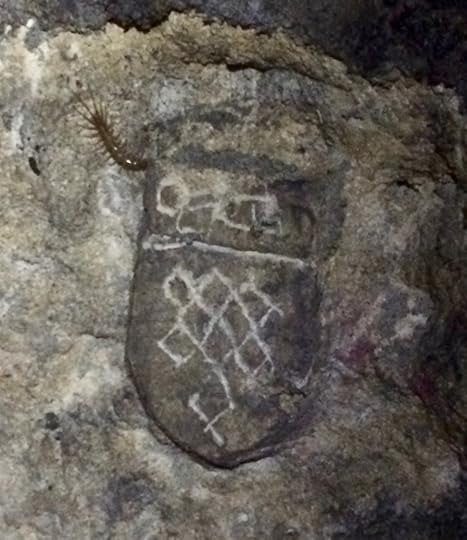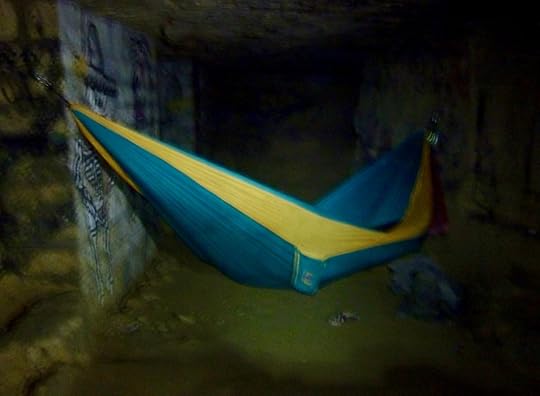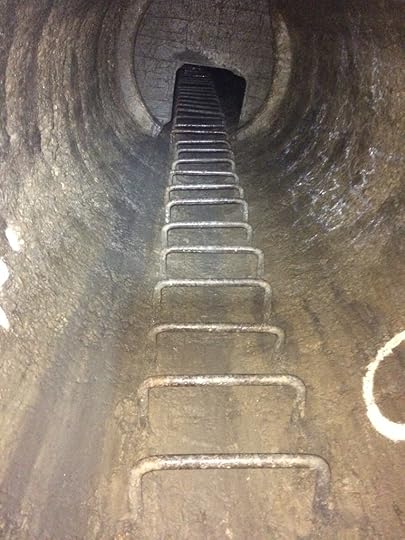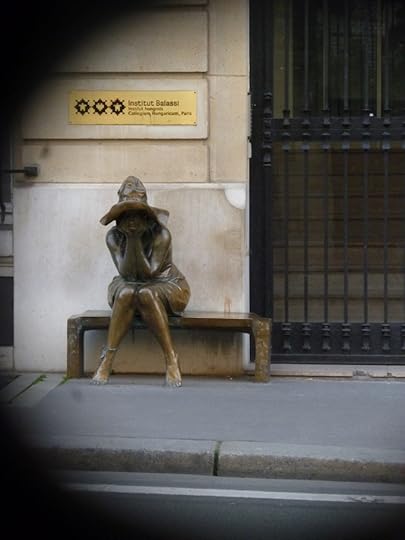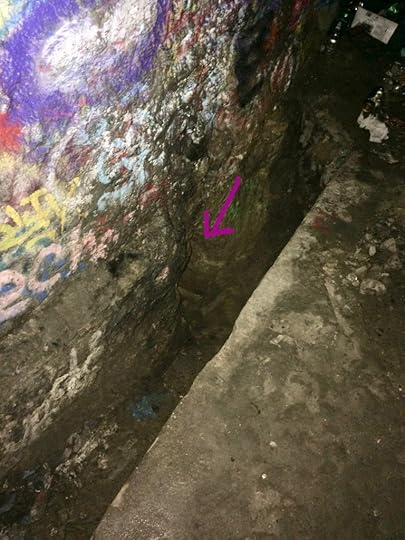Amy Plum's Blog, page 5
March 17, 2017
Visiting Paris’s off-limits catacombs: Part 5 Bones
This is Part 5 of my adventures exploring the off-limit catacombs under Paris. Here are Part 1, Part 2, Part 3, and Part 4.
I visited Paris’s Ossuary for the first time in the 1990s. It’s the open-to-the-public part of the underground network that everyone thinks of when you say “Catacombs.” I was so enchanted by it that I have returned several times over the years. Its well-ordered bones, beautifully arranged and laid out for the purpose of visits (which have been extremely popular since it opened in the early 19th century) are fascinating partly for the creep factor and partly for the beauty of art made out of, well…us.
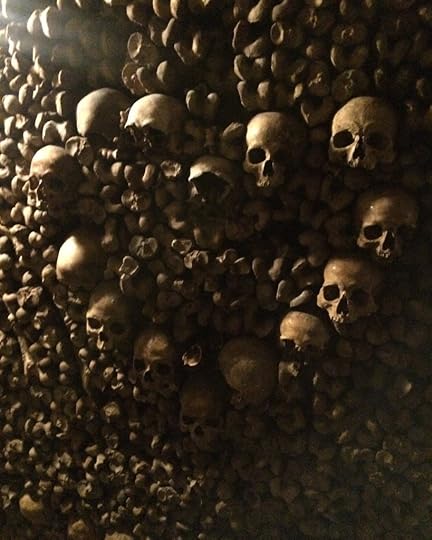
Paris’s ossuary, during my last visit in December 2016.
But the main reason I was drawn to it was the knowledge that every one of those millions of bones…the remains of more than six million people…had a story behind it. There are perfectly round holes in some skulls that suggest a bullet wound. There are the men who, for two years (1786 to 1788) carried the bones by dark of night in black cloth-covered wagons before dumping them down manholes. (More were added afterward).
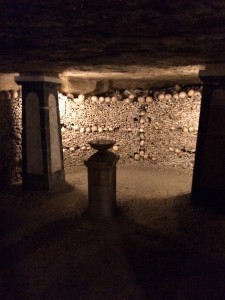
Paris’s ossuary, during my last visit in December 2016.
And there is my curiosity as to just why Louis-Étienne François Héricart-Ferrand (director of the IGC after Charles-Axel Guillaumot (read Part 4), decided to arrange all of the bones in the geometric—even heart-shaped—designs that visitors see today. Had he seen the Capuchin Crypt in Rome, with the monk bones arranged into ghoulish maquettes complete with flying skeletons? (Which predates Paris’s by almost 200 years.)
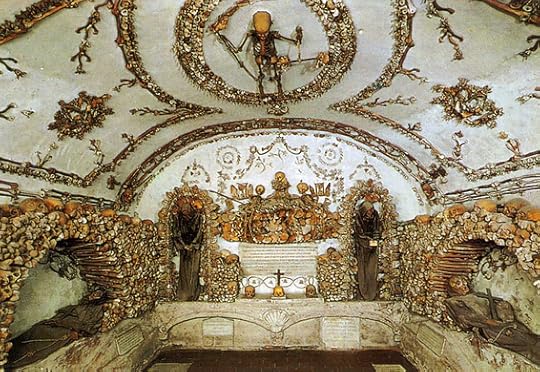
Crypts of the Capuchin monks at Santa Maria della Concezione, Rome. (photo: Atlas Obscura)
So it was to my great surprise (and not a little bit of delight) that Gilles, the artist and I turned a corner in the non-ossuary part of the catacombs to see a couple of bones lying on the floor. “Are those…human bones?” I asked. Gilles didn’t answer. He just watched me carefully, unsure if I was going to freak out.
I’m not sure if it was a relief or a shock to him when I crowed, “Bones!!! There are bones!!!” and ran around delightedly taking photos.
I have a special relationship with Death. (Okay…let’s just put it right out there and call it odd.) Death features prominently in all of my books. I used to hang out in cemeteries as a teenager and in my early twenties (and even more so now that Père Lachaise is within walking distance). I travel with my mom’s ashes, so she is now floating in the Thames, the Seine, the Arno, the Danube, and the little pond in Central Park. And my collection of taxidermy and (animal) bones was a source of amusement to my friends and family until my Labrador puppy ate them all last year.
When my four-year-old daughter dug up a beaver skull in our backyard in the Loire Valley, and carried it into the house like a trophy, insisting that I display it on our mantle, I knew she was flesh of my flesh, and unquestionably bone of my bones.
Back to the catacombs…we followed the trail, which grew larger as we proceeded down the tunnel.
Gilles explained that after an extention was built onto the Ossuary in 1859-1860, Paris planners realized they needed more space to store even more bones. After 1870, they decided to put them in the quarries under Montparnasse Cemetery (where we were standing) as well as Montrouge cemetery and others. And since these were not going to be viewed by a ticket-paying public, they were unceremoniously dropped through manhole covers and left to assemble themselves. Or not.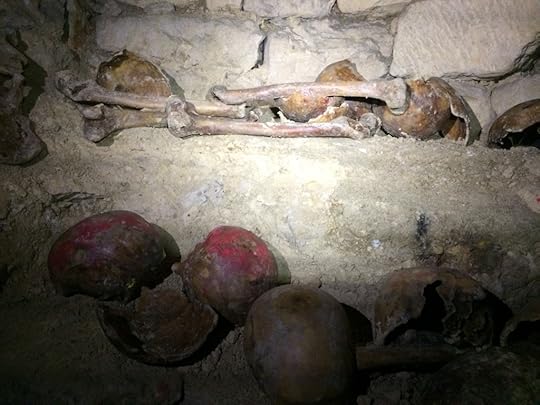
Finally we came to this corridor:
and I thought my joy was complete. Until we went just a little further and found this:
An actual THRONE OF BONES. I’m not sure who came up with this idea, but if you’re reading this right now…I’m single.
Just because you worship something doesn’t mean you can’t touch it. Or sit in it. But not before whispering to the bones, “I respect you, but just give me a second to take a photo, and I promise I’ll leave you in peace. And oh, can I hold this tibia as a scepter?” I’m not saying I did it. But I’m not saying I didn’t.
And as soon as we left the Montparnasse Cemetery area, the bones disappeared.
They hadn’t been framed by all of the beautiful carvings and signs that the official Ossuary boasts. But near the beginning of our tour, I took a photo of a carving that Gilles said was relatively recent. It’s the perfect accompaniment to the Montparnasse Cemetery bone dump, and a bit of a shame that it isn’t closer.
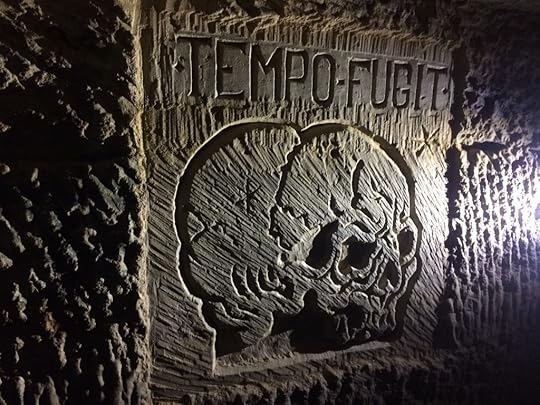
A musical riff on tempus fugit, reminding us that time flies.
And if that’s not enough of a reminder, an amazingly talented cataphile artist known as “Lone” left another nod to our mortality on one of the few large walls in a “fontis” (bell-shaped cave formed by a tunnel collapse). It took him the entire year of 2010, and is a rendering of the Swiss Symbolist artist Arnold Böcklin’s painting “Isle of the Dead” (the version painted in 1883, incidentally bought at auction in 1933 by Adolph Hitler and now part of the collection of the Alte Nationalgalerie, Berlin).
The mural is so large and the space around it so small, that I could only capture it in several separate shots.
It depicts a shrouded corpse standing in a boat behind a white coffin, being rowed to the eponymous isle.
At the base of the mural, the artist has given us a palindrome (reads the same in both directions) sometimes attributed to Virgil meaning “We spin around the night consumed by the fire.” (It’s also the title of a French film, and was used by Umberto Eco in The Name of the Rose.)
It’s a beautiful, if not a teeny bit morbid, metaphor for the catacombs: the humans that flit through its passages like moths, quickly devoured by the flame of time while the tunnels remain as an underground time capsule, preserving our traces for future generations to discover.
And on that cheery note, I’ll end for today. The sixth and last installment tomorrow, featuring NAZIS IN THE CATACOMBS (and anything else I’ve forgotten to tell you).
March 16, 2017
Visiting Paris’s off-limits catacombs: Part 4 Revolution
This is the 4th installment of my adventures in the off-limit Paris catacombs. Here are Part 1, Part 2 and Part 3.
Wandering 60+ feet below the surface of Paris, three specific periods of time seemed to jump out at me. I talked a little bit yesterday about the 1980s, and the crews of cataphiles who adopted the catacombs as their sacred place for art, partying, exploring, and taking refuge from the hustle and bustle of the city above. I mentioned the creation of the catacombs around the time of the French Revolution and the untimely death of Philibert Aspairt soon after their creation. And then there are the traces of the Nazis during the German occupation of Paris in World War II. I’ll talk about that more later. But for now, let’s go back to the beginning.
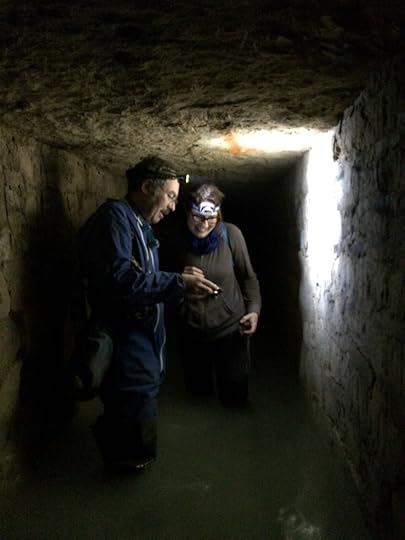
Gilles Thomas giving me the history of the catacombs, inscription by inscription.
Like I mentioned in Part 2, the story of the catacombs began with the collapse of a limestone mine in 1774, which swallowed a whole street of houses (and people) along what is now avenue Denfert-Rochereau.
This prompted King Louis XVI to pass a royal decree in 1777 that a special commission would inspect the mines. (Um, yeah…a whole 3 years after the disaster. Bureaucracy seems to have been just as bad, if not worse, back then.) The Inspection générale des carrières (IGC) was founded and Charles-Axel Guillaumot (the king’s architect) was named chief inspector.
He took on the task whole-heartedly, working with a team of eighteen men. Like I mentioned before, Guillaumot and all of the inspectors after him each left their mark. And if you know the code, you know who was in charge when each pillar was reinforced. (Finding a “G” for Guillaumot is a special thrill!)

 (table copied from Wikipedia.fr: Inspection Générale des Carrières)
(table copied from Wikipedia.fr: Inspection Générale des Carrières)
As you can see, Guillaumot was inspector twice: for 14 years, then a five year gap, then again from 1796-1807. Can anyone guess why? Yep…it was because of this little thing called The French Revolution.
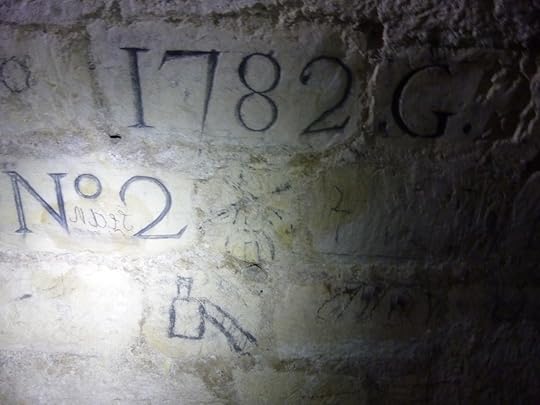
Pillar #2 by Guillaumot, reinforced in 1782—before he was thrown in jail. (The drawing underneath would have to date after the wall was built, of course.)
Since Guillaumot had been appointed by the king, the revolutionaries didn’t look kindly on him and threw him in jail. But he was given his job back in 1795 (Napoleon recognized his importance to the project) and his “G” once again appears on inscriptions using the Revolutionary calendar, like the one below. He kept working on his prize project until he died in 1807.
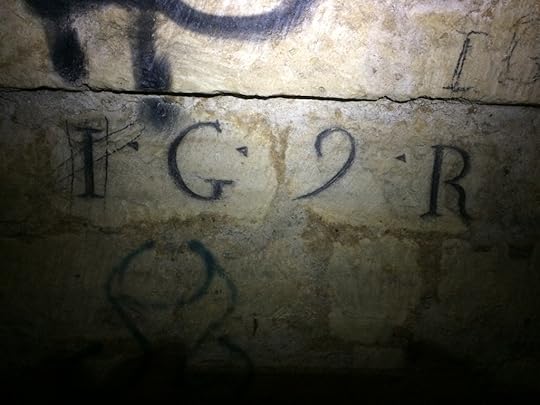
Pillar I by Guillaumot in the 9th year of the Revolution, or 1800, 5 years after Napoleon let him out of jail and gave him his job back.
Near the end of Guillaumot’s first stint, Louis XVI was guillotined (on 21 January 1793). Starting that year, all signs of royalty were ordered destroyed. Therefore, all of the fleur-de-lys that were carved into the catacomb’s signs were scratched out.
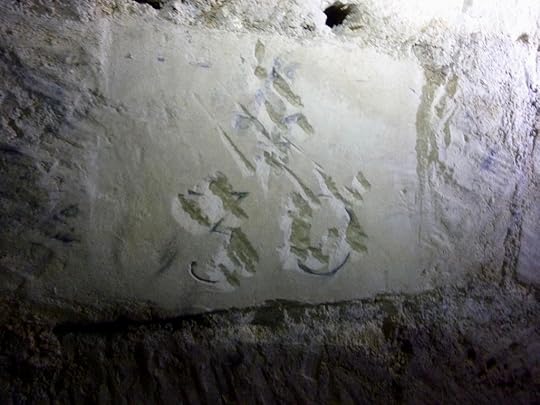
Scratched-out fleur-de-lys and number 30.
But that wasn’t the only thing that changed. Before Napoleon, the streets were numbered 1, 2, 3, 4, 5… up one side of the street, and then coming back down 10, 11, 12, 13… In 1805 Napoleon instated the system that is still used today: even numbers on one side of the street and odd on the other. (The numbers start at the Seine with 1 and go higher as you get further away from the river, or for east-west streets start with sunrise, at the east, and get higher in the direction of sunset, at the west of the city.)
So when you see a number scratched out, and the new address carved in its place—topped with a star—you know that dates from 1805 or later. (My photo of the starred address looks like I shot it while running for my life. I will spare you.)
HOWEVER…the people tasked with scratching out the fleur-de-lys missed a few. Ten, to be exact. And Gilles led the artist and me to each and every one, letting us find them ourselves on a mini-scavenger hunt. They weren’t easy to find—which is the reason they were missed in the first place! One had been in a pool of water. The other behind another sign:
And others had lost their color or were in unexpected locations:
Also, thanks to the Revolution, all signs of religion were destroyed, so streets with saint names were changed, thus rue St. Jacques becoming plain old rue Jacques. During the restoration, some of these were once again altered, but if there was no space a tiny “St” was carved in between words.
But my favorite remnants of the Revolution aren’t the official ones. They are the graffiti left by the cataphiles of the day.
As I learned while studying Napoleon with my eleven-year-old son a couple of weeks ago, the general-turned-emperor became reviled for (well, for a lot of things, but especially for…) as one poet said, “taking all of our sons”. Napoleon’s battles were bloody, and a great number of France’s young men were killed during his short reign. One of the unfortunate boys to be enlisted went down into the catacombs to express his grief over choosing the lottery number that ensured his army inscription. (I can only imagine it would be treason to express it anywhere above-ground!)
I can’t read the whole thing, but it gives his name, says he was born in 1789…. “drew in 1809 the number 197″… and the rest basically says “in drawing that number, the people of France chose my fate.” In just one of the battles of 1809, Napoleon lost 23,000 men to the Austrian army. We can only hope that this boy was one of the few to survive.
This one shows a Napoleonic soldier. The date 1813 is written above it, which happens to be the year of the Battle of Leipzig, which cost more than 90,000 men their lives.
Not far away, in the same corridor, Gilles pointed out a drawing and asked, “What do you think this is?”
After a moment’s thought, I said, “A guillotine, with a ladder going up to its platform.” Gilles looked at me so strangely that I thought I had gotten it wrong, but apparently I’m the first person who answered his question correctly. (!) The theme is repeated in a more detailed drawing on the wall facing.

Print showing the 1794 execution of Robespierre, copied from richardnilsen.com. (No date or artist listed).
Which is quite similar to the one used to execute Robespierre, complete with side-railings.
However, in the catacombs version, the artist has gone all-out and included ladder-railings and a basket to catch the severed head beneath the guillotine.
And on that note, we will close today’s history-lesson-slash-treasure-hunt, because tomorrow I’ve got something I know you’re all going to love: BONES. Lots of them.
A demain!
March 15, 2017
Visiting Paris’s off-limits catacombs: Part 3 CataEverything
This is part 3 of my adventures in Paris’s illegal catacombs. Here are Part 1 and Part 2.
Before I take you further into the catacombs, let me tell you a little about the people who go down there.
The term cataphile is a self-appointed moniker by those who enjoy this particular form of urban exploring. People have been visiting the catacombs since the tunnels were first dug to connect the network of separate mines.
One of the most famous cataphiles dates from the Revolution. Philibert Aspairt’s corpse was found in the catacombs in 1804, eleven years after he went missing. His widow identified his body, saying he had disappeared in November 1793, but she had no idea why he would have been in the catacombs. The cause of death was never determined, but one thing was clear: he died there because he couldn’t get out.
His body was found near the quarry beneath the Capuchin monks’ monastery, near the locked door where they stored their homemade liquor. But Gilles said it would have been easy enough for Philibert to have stolen their liquor by breaking into their basement from the street, if that had been his intention. Gilles’s theory is that Philibert’s reason for being in the catacombs was the same as ours: curiosity and the thrill of exploration.
He was buried near where his body was found, not a very restful resting place since the noise of Paris’s RER trains seems to be loudest in this spot. (Still just barely a rumble.)
Needless to say, Philibert’s sad end didn’t stop people from exploring. And there was a boom in the practice in the 1980s, when crews of cataphiles began regularly visiting the catacombs. One of the best known was “The Rats”, who are behind some of the tunnels’ most interesting artworks, including this AIDS-themed wall:
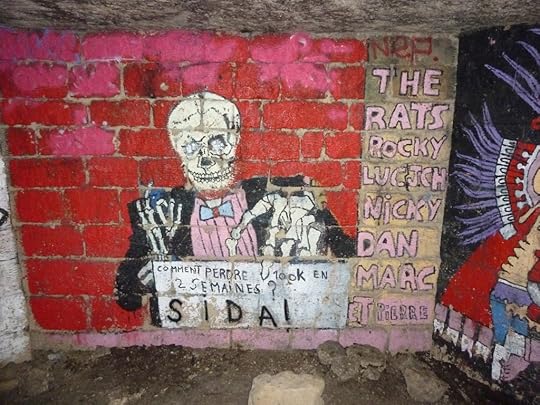
Translation: “How to lose 100k in 2 weeks? AIDS!” The names of the rats are listed down the right.
A whole vocabulary began to be used: there were cataboys and catagirls, one of the most famous being Foxy. When she died of cancer, a memorial plaque in the style of Philibert Aspairt’s was created by her fellow cataphiles. My photo of the plaque didn’t turn out since the guy taking a nap in his hammock (in Part 1) was blocking the view. But here is a portrait of her on a nearby wall:
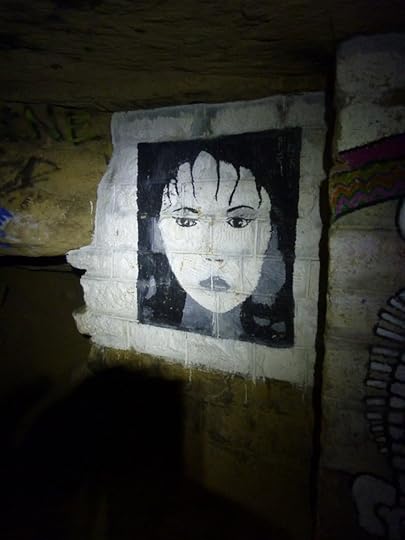
Catagirl, Foxy
and a mural facing her memorial plaque of a fictional bar made in her name:
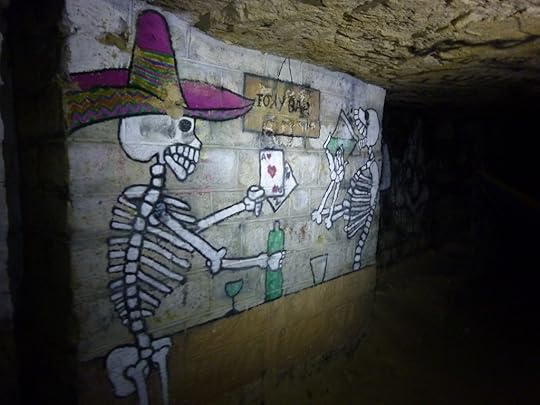
“Foxy Bar” mural, with skeletons drinking something green. (Absinthe?)
But not all visitors of the catacombs can be considered cataphiles. There are the cataclastes: people who come down with spray paint and deface old inscriptions, steal plaques, and leave their trash behind. They don’t respect the place like the cataphiles, who tend to have a worshipful we-are-the-keepers-of-the-catacombs attitude.
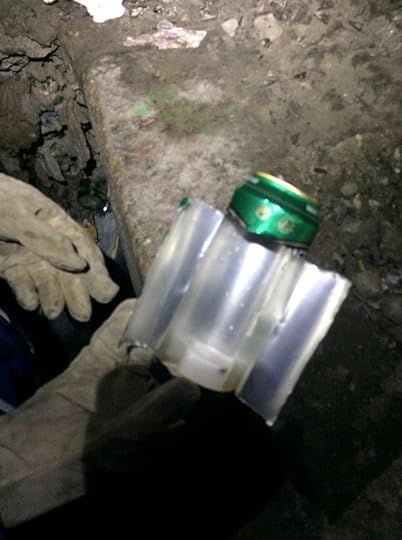
Catalamp, made out of beer can and candle. The cataphiles brought it out of the catacombs and dumped it next to the entrance hole…because it’s okay to litter once you’re outside. ;)
And then, there are the catacops (in French “cataflics”). They are a group of police who are assigned to the catacombs, as well as having other surface-level activities. They sweep the catacombs from time to time, giving 60-euro tickets to anyone they find there, and escorting them back to the surface level. They also keep track of any new passages made by cataphiles. (More on that later.)
The most famous catacop was Jean-Claude Sarette. (Look him up – he even has facebook pages dedicated to him!) He was known to respect the catacombs, unlike the catacops of today who spraypaint big ugly red numbers at crossroads so they can locate themselves on their own map. (Even though street names are clearly indicated on most corners, and used by the cataphiles, who don’t need big red numbers to figure out where they are.)
Although Sarette ticketed cataphiles he found, they all loved him, and when he retired after twenty years on the force, they erected a Paris street sign-style plaque in his name…
…and, according to Gilles, gave him a huge farewell party…in the catacombs. When Gilles told me he had been on the phone with Saratte a few days ago, and had told the retired catacop that he would be giving me a tour, I got the biggest thrill. Like someone had mentioned me to Maira Kalman. Or Neil Gaiman. Or someone else I semi-worship.
Cataphiles…cataclysts…catacops…cataboys…catagirls. They have their own legends, and even their own songs, like this 1980s punk homage to everything cata, and a good reminder that you didn’t have to be able to sing or play an instrument to be punk. (Lyrics in English here.)
http://www.amyplumbooks.com/wp-content/uploads/2017/03/Salut-a-toi-kta.mp3
But the goal of the cataphiles isn’t just to party underground or find a cool spot to make giant murals. It is exploration. And the only reason Gilles, the artist, and I had to worm our way through little tunnels during our 10-hour tour is because of the vent holes (or chatières) the cataphiles have dug to link one tunnel to another.
The reason they do this is twofold: one is to find spaces that were not included in the original survey. And the other is because a tunnel has been blocked, either accidentally because of cave-in or (more often) because the City of Paris has blocked a tunnel so that no one will go there: either a few hundred years ago, or more recently.
After everything I’ve told you, I’m sure you can imagine what cataphiles do when they find a tunnel cemented over. Yep. They dig around it. Like here:

Squeezing around a blocked-over passage.
The cataphiles have also cleared areas that had been used as debris dumps in order to have space to sit around and eat, or stand around and chat, or, in the case of La Plage (The Beach), throw huge dance parties.
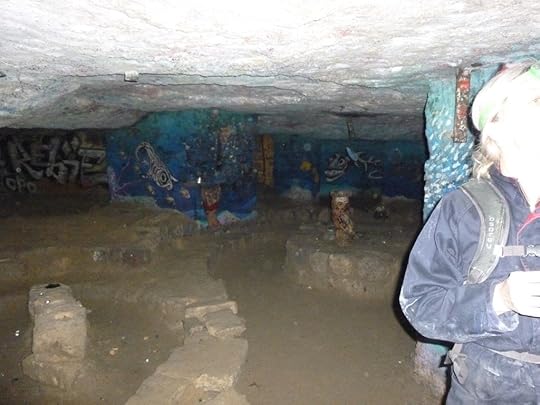
La Plage (the beach): the largest open area I saw while in the catacombs.

The Rats’ interpretation of Japanese artist Hokusai’s painting “The Great Wave of Kanagawa” at La Plage.

Other side of The Rats’ pastiche of Hokusai, which was spraypainted over by cataclasts, and lovingly restored by cataphiles.
We came across a small party at the beginning of our tour. It must have been around noon (on a Sunday), and there were a dozen twenty-year-olds sitting in a small cave, very drunk and very merry. Gilles went in and asked them what time it was. A boy said, “It’s always night down here.”
As we left, one of them followed us out. “That wasn’t Gilles Thomas, was it?” he asked suspiciously.
“Yes,” I replied.
“No,” he said, his face stretching into a Edvard Munchian scream.
“Yes,” I replied.
“No. Really, don’t joke about something like that. That wasn’t really Gilles Thomas, was it?” He looked like he was about to faint.
“Yes,” I replied.
He kept standing there arguing with me about Gilles’s identity, until I finally turned and left him gawping, so that I could hurry after my legendary guide who had heard the boy’s questions and scuttled off to avoid hero worship. For it seems that, among all of the other cata-legends, Gilles has his own place in cata-mythology.
THE STORY CONTINUES TOMORROW. But here’s some more cata-eyecandy to hold you over:
March 14, 2017
Visiting Paris’s off-limits catacombs: Part 2
Welcome back for Part 2 of my catacombs adventures. Here is Part 1.
Once we passed through the tiny hole that gave us access to the catacombs, we were able to move standing up for a while. Most of the passages are like this:
…wide enough to walk through, but not to stretch your arms out straight. I was slightly stooping most of the time. And about 1/4 of the passages we went through had lower ceilings, so that you are actually folded over double while you are walking/scrambling.
Let me pause here to tell you just what these tunnels are. Before Paris even existed as the city is now, there were many mines on the outskirts…mainly for the limestone used to build the buildings you see in Paris today. At the time, that land was farmland, so no one thought about security. But as Paris grew, homes were built on top of land that had been hollowed out, and the more buildings perched atop these holes, the more dangerous it was.
This oblivious co-habitation of city and deep holes continued until 1774, when a whole street of apartment buildings and homes fell through the ground. Louis XVI named a commission to inspect, chart, and reinforce the mines. (The Inspection générale des carrières or IGC.) So Charles-Axel Guillaumot (the chief inspector) and his crew went around to all of these individual mines and made tunnels from mine to mine, connecting them. They raised their ceilings from the crouching height miners were forced to work in to a height that allowed men pushing wheelbarrows to get through. They reinforced the walls and ceilings and labeled them all as they made their way through.
So what was before a collection of individual mines were all connected now…thus creating the network of catacombs we have today. (I am simplifying greatly, but you get the idea.)
Back to the tour. As we made our way through the tunnels, Gilles pointed out Guillaumot & Co’s handiwork, especially the system of labeling that he had established. Markers were drawn on the walls in pencil/charcoal and afterward, stone-carvers (the same guys who carved tombstones) came through and carved what they saw in pencil permanently into the wall. (Because of the humidity, the pencil marks all lasted.)
Here is one example:
Beneath the inscription “Graves of the Lazarists” is 12 (the marker indicating which reinforcement or pillar) F. (the initial of the IGC inspector currently in charge) and the date it was inspected (in this case 1866).
Most of the markers in the catacombs follow this formula, except when the stone carver got confused like here:
 and put the date first, the initial, and the 2 after, then scratched out the 2 and kind of shoved it below and in front. (And for those of you who can guess what the tiny drawing is beneath the numbers, it dates from the same year, and there will be more on that topic later.)
and put the date first, the initial, and the 2 after, then scratched out the 2 and kind of shoved it below and in front. (And for those of you who can guess what the tiny drawing is beneath the numbers, it dates from the same year, and there will be more on that topic later.)
Besides the IGC markings all over the place, there are other official markings: street names and, in a small percentage of tunnels, the numbers of the houses or names of important buildings directly overhead.
As for street names, they can be either on plaques (many of which have been stolen):
Or carved into the wall:
like “Diagonal between the Big and Little Avenue of Midi”.
So you noticed the water in the photo with the street-name plaque? Let’s use that to get back into the tour itself.
Very soon after crawling through the hole, we began walking through large puddles of water on the floor. Very cold water. It soaked through my hiking boots, and chilled me right through. Gilles reassured me that it was because we were still near the entrance, and the water wouldn’t be that cold throughout.
Which I soon discovered when we hit an area where the water was waist-high. Gilles showed the artist and me how to straddle the tunnel, putting our feet on a tiny ledge on either wall—the ledge sometimes being a bit above, and sometimes a bit below the water (so invisible). At one point, my right foot slipped, and I stepped down to the center of the floor, soaking myself up to my butt. (I’m 5’9″, BTW.) I quickly regained my footing, and that was the deepest I went for the rest of the tour.
The water in the cave was crystal clear, except when it wasn’t. Which meant that someone had recently walked through and stirred up the mud. Meaning we weren’t down there alone. There was no odor besides humid rock except when we came across other cataphiles who were smoking (smoke smell), drinking (booze smell), burning candles (wax) or using some kind of lantern that had a chemical smell. This was rare, though, since we probably only saw 15 people in the 10 hours we were down there.
One note about smell, though. At one point I smelled a cigar, and even saw smoke hanging there in the air, as if it had no where else to go. I asked Gilles how long it would last before it diffused in the 90% humidity. “Three hours,” he told me. “Like a woman’s perfume.”
Which of course sparked a million storytelling synapses in my mind. An odor lasts three hours in the catacombs. Which means the culprit can’t hide her presence for that long if she leaves an olfactory trace. DULY NOTED!
It was also around the time that I was wading through thigh-high water that I asked Gilles about the fauna of the catacombs. There are no animals, he told me. Not even rats, because there is no food for them. The artist who was with us said she had heard about animals, like a fox, getting lost down there, but that was rare. And the whole time we were down there I saw only 2 spider webs (no food for spiders either?) and this:
oh…and this guy taking a nap…
But we won’t count him, because who the hell takes a nap in the catacombs?
One last thing for today: depth.
This is how deep we were. (The ladder goes way up above where it disappears at the top of the photo.) I think Gilles said we were 8 meters (26 feet) down in most places, and as high as 5 meters in others. And once we even climbed all of the way to the surface, up a staircase and behind a locked metal door, and peeked out of this keyhole
to see a sculpture across the street, and unsuspecting people walking by just a few feet away from three people wearing head-lamps and soaked and muddied to the skin.
Note on this particular locked door: Many years ago, two Nazi uniforms were found just behind it, where we were standing peeking out through the hole. Which means, unless they were ambling naked through the streets of Paris, two Nazis changed out of their uniforms, put on civilian clothes, walked out through the door into the above-ground world, and never made it back for their uniforms.
Alternate scenario…non-Nazis acquired Nazi uniforms, wore them underground, and then changed into their regular clothes before going out in the world. Since the uniforms are all we’ve got, the story is up to you. And trust me, there are a million stories lurking below the streets of Paris. More on that…
TOMORROW!
March 13, 2017
Visiting Paris’s off-limits catacombs: Part 1
One of the first attempts I made at fiction-writing was when I was 24 and living in an ancient building in the Marais. Every time I went down to my basement storage space, I would gaze longingly at a separate set of stairs that went down even lower…old stone stairs that descended into the darkness. Each time, I had this intense longing to follow them down, and would even tiptoe down three or four steps. But there were rats. Big rats that seemed to scuttle around with supernatural speed. Rats were a deal-breaker for me.
I ended up writing a story about Paris’s underground tunnels as a sort of time traveling machine. When you came up, you’d be in a different year than when you went down. Unfortunately, there were large talking rats in my story, and one of my friends read it and said it was total crap. So I trashed it and didn’t try my hand at fiction for another fifteen years.
Even then, when I began writing the DIE FOR ME series, I still couldn’t stay away from underground Paris. It’s a feature in every book of the series. I have visited the official Paris Catacombs (the Ossuary, where all the bones are) four times, and drew my knowledge from that and a bit of online research. But I had never experienced the true non-touristy catacombs of Paris…the fabled areas where all of the fascinating history I had read about…dreamed about…took place. Until yesterday.
I decided that for my 50th birthday, I wanted to do something I had never done before. I contacted a guide I had used a few times for private tours to ask if he would take me to the illegal part of the catacombs. He told me he couldn’t, but he knew someone who could. But he wouldn’t give me the guys name. He said he would contact me.
“The guy” turned out to be Gilles Thomas, who told me he’d be happy to take me and my friends on a two-hour tour of the abandoned tunnels under the Cochin Hospital. They are lit with normal lights, you don’t need equipment, and it’s not hard-core. I said that sounded wonderful, but what I really wanted was The Other Tour. *nudge nudge* He kind of waffled about it and said I should come to his office to clarify what I was looking for.
Now I believe that it was a test. He wanted to meet me in person and make sure I wasn’t a complete wimp. Also, once our meeting began, he had me define very specifically what I wanted. “The illegal parts…yes, in the dark…yes, in the water…yes, for hours and hours…yes, I understand we could be caught by the police and given a fine.” He warned me that if I was in the least bit claustrophobic, I shouldn’t go. That if I freaked out in the middle of the tour, it could be an hour and a half back to an entrance. I put on my most confident nothing-scares-me expression and told him that’s exactly what I wanted. I could tell that I had succeeded when he got a little gleam in his eye. I had passed the test. I asked him what his fee was. He said, “Homemade chocolate cake.”
I choked. “For a nine-hour tour?”
“It has to be homemade,” he repeated.
“But can’t I give you something else? I could translate one of your articles. I’ve translated historical documents, t.v. shows, books…”
He looked hurt. “My fee is chocolate cake.”
“Chocolate cake. Fine!” I said quickly, before he changed his mind.
He gave me a time and a place to meet him—on a street corner in the south of Paris—told me to wear a head-lamp and shoes I didn’t care about ruining…but not rain boots because they would just fill up with water. And that was that.
Until I went home and did some research on him. And I discovered I was getting a tour from The Expert of all experts. The guy who, for the past thirty years, has held a mythical role in the hierarchy of cataphiles. (Those whose passion is exploring the off-limits catacombs.) The guy who has written seven books on the topic, including:
Which kind of says it all, right? Not to mention that he is the go-to guy whenever anyone important wants a visit. Including George R. R. Martin. And Pixar’s team planning Ratatouille. And the makers of As Above, So Below (which Gilles swore he never saw). And every other important thing that is written or filmed about the catacombs. I thanked my lucky stars that I had somehow stumbled into this chance of a lifetime, and began getting my ducks in a row: buy headlamp, get dogsitter, plan a chocolate cake that would be worthy of a Gilles Thomas tour.
Gilles phoned me the night before my tour, and from his voice I could tell he was wondering if I had decided to back out. I reassured him that the cake had already been baked and iced and I was ready to go. I was excited. And a tiny bit nervous. But I went to bed, knowing the next day I would have one of the most amazing experiences of my life.
I woke up yesterday with full-blown jitters, after having a series of complicated nightmares where Gilles had given me a list of things to take that I wasn’t able to get together, that the cake wasn’t acceptable, that my kids were along for the trip and I had to protect them. I choked down my breakfast, drank about four cups of coffee, and got together:
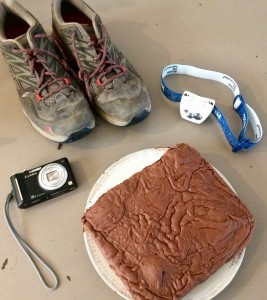 (I decided on buttermilk brownies instead of cake.)
(I decided on buttermilk brownies instead of cake.)
Then packed a bag with this:
 Towel in a plastic bag (because Douglas Adams), apple, sandwich with 10 euros and a metro ticket sealed in the bag with it in case I dropped everything in the water, my identity card in case someone needed to identify my body, scrunchie to tie back hair, and no bottles of water because I knew there wasn’t a bathroom down there.
Towel in a plastic bag (because Douglas Adams), apple, sandwich with 10 euros and a metro ticket sealed in the bag with it in case I dropped everything in the water, my identity card in case someone needed to identify my body, scrunchie to tie back hair, and no bottles of water because I knew there wasn’t a bathroom down there.
I waited nervously on the appointed corner until I saw Gilles walking toward me in thigh-high green waders. Within minutes, another person joined us—an artist who has gone through the catacombs with Gilles several times and is working on a catacomb-themed art project.
And we were off. Through a gate, down a hill, down a very long, dark passage (Gilles has asked me not to be more specific) until we reached this hole:
“Here we are!” Gilles said.
“Where?” I asked. “In that gutter?”
“The hole’s right there,” the artist said, pointing to a crack in the wall.
“I’m going to have to squash the cake,” I said, trying to think of anything besides hyperventilating.
“That’s fine,” Gilles said, and started squeezing his 6’2″ body through the crack.
I mashed the bag I had holding the cake in into my backpack, and got on my hands and knees, and thought of wide open spaces, and followed Gilles and the artist through the crack in the wall and down into the darkness of the catacombs.
[Continued tomorrow…but if you want to see the crack-entrance, look at the 1:15-2:05 mark of this video that I found of some cataphiles using the same entrance:
(Translation: “This hole is the entry to the catacombs. This hole is smaller than me.” “Oh, f***.” “Oh f***!!!!!” “To get out is it easier than this?” “Yes to get out it’s easier.” “Oh f***.” ) Um…I couldn’t have agreed more.
March 10, 2017
Classic Children’s Book Quiz
A couple of weeks ago, I gave a baby shower for one of my favorite people here in Paris, Celeste Rhoads (who is the Children’s and Teen’s Librarian at the American Library of Paris). It had to be book themed, of course, so everyone brought a copy of their favorite children’s book for new baby’s library.
And then there was this…
We also played a Classic Children’s Lit trivia game (with potted pansies as the prize).
I thought you would enjoy playing. How many of these classic book questions can you get? (The winner got 22 points!)
Classic Children’s Book Quiz — Celeste’s Baby Shower
1. What did the narrator of the Little Prince like to draw as a child and what did adults think it was?
2. What is the name of the mutinous ship’s cook in Treasure Island?
3. Who is Curious George’s roommate?
4. Give one phrase Charlotte weaves into her web to save Wilbur?
5. What is Violette’s vice in Charlie and the Chocolate Factory?
6. What species is the villain in Jungle Book? (Extra point for his name.)
7. What book acts as the world-building compendium for Lord of the Rings?
8. What species is Puddleglum in the Silver Chair (and VotDT)?
9. One point of each of the names of the three witches in A Wrinkle in Time.
10. What is Paddington Bear’s country of origin?
11. Who are Toad’s two best friends?
12. Where does Toad live?
13. What was TinTin’s dog’s name (either French or English).
14. Name one of the main themes of Are You There God? It’s Me, Margaret?
15. What is the name of Frodo’s Uncle in The Lord of the Rings?
16. Who is the musician in Asterix?
17. What is the profession of Pippi Longstocking’s father?
18. What is the name of the love interest in Anne of Green Gables?
19. What do Digory and Polly use to travel between worlds in The Magician’s Nephew?
20. What is waiting in Max’s room when he returns from ruling The Wild Things?
21. What animal appears on every double-page of Goodnight Moon?
22. What is Dr. Seuss’s real name?
23. Who is the nun who runs Madeleine’s boarding school?
24. What did Pooh use to reach the beehive?
25. Who are the witches in The Wizard of Oz? (Names not needed.)
Bonus contemporary questions:
1. What is the name of Hermione’s cat?
2. What are the five factions in Divergent?
3. What flower is President Snow associated with in Hunger Games?
March 1, 2017
Rooftop Ramblings Live Facebook Interview + win DREAMFALL ARC!
So happy to have my first in-person interview for Dreamfall. It’s one that ALL OF YOU can attend because it’s live on Facebook. (And I’ll be giving away an ARC!)
Join me on Rooftop Ramblings this Saturday (March 4) at 2pm Paris time (that’s 8am New York time) by going to this Facebook page: Paris in Person. If that’s too early for you, the video will be posted later. The interview is with Boris and Sam, these two guys from my book club:
 Who knows what they’ll ask? (Be prepared for anything.)
Who knows what they’ll ask? (Be prepared for anything.)
And if you send a question ahead of time, I’ll put your name in the hat to win an ARC of DREAMFALL. Your question can be about anything – just send it any time between now and 8am EST to : podcast@parisinperson.com
See you Saturday!
February 14, 2017
Valentine’s Day blast from the past
On this Valentine’s Day, I thought a few of you might like to re-visit the DIE FOR ME universe.
This is Charlotte’s Valentine’s letter to Ambrose. The one she wrote every year, but never showed him. And you all know how that ended up! (Some people totally deserve their happy endings.)
So here’s paean to unrequited love for your Valentine Day…
Charlotte’s Valentine Letter
Today is Valentine’s Day—le jour de la Saint-Valentin. The day of lovers. The only day of the year I can’t look you in the face. Because on this day, I can’t keep my mask from slipping just slightly, and I don’t want you to see what’s behind.
I have known you now for almost seven decades. Lived under the same roof as you for sixty-eight years. I know you as well as my own twin brother.
I know how you’ll react to any given situation. What you will say. How you will respond.
Which should mean that by now I should be totally bored of you. Your predictability should make me yawn. Seeing you in the same scenarios day after day, year after year, should make me roll my eyes. And yet, it doesn’t.
Instead, I find myself anticipating your reactions and congratulating myself on guessing them right every single time. When I hear your laughter ring through the house when you come home, I am unable to resist the smile it brings to my lips. I love you, Ambrose. Passionately. Irremediably. Hopelessly.
It wasn’t love at first sight. When Jean-Baptiste carried your body back from that Lorraine battlefield, I found you intriguing in your complete Americanness—your Yankee bravado. Your passion for jazz and film and dancing brought a welcome breath of life to our household of kindred. I liked you for all those things. Loved you as a brother.
Until I got to know you better. Your joie de vivre was infectious. It infected me. It made my heart swell with happiness—not only when I was with you, but when I learned to see the world through your eyes. You brought me joy, and I should be satisfied with that. But I’m not.
When Charles told you how I felt and you admitted to him that your sentiments weren’t the same, I spent the next decade hoping you would change your mind. Doing everything I could to make you see me in a different light: desirable, not little-sister-ish.
When that didn’t work, I spent the next ten years trying to be okay with my lot. To find someone else. But while you are here living with me, walking with me, joking your way through every meal, my heart can go nowhere else.
Now I’m resigned. As I do every year, I will finish this letter, feel a bit better for it, and then place it in the back of my journal. It will join the other forty-three letters to you. Forty-three declarations of love that you will never see.
On this Valentine’s Day I wish I could tell you that even though you don’t love me the way I love you, every day with you is a gift.
[If you want to read more excerpts, behind-the-scenes material, and deleted sections, download INSIDE THE WORLD OF DIE FOR ME.]
February 5, 2017
Dreamfall Interview: Who’s My Favorite Character?
I hope you’re busy playing the YA Books Central Scavenger Hunt, which started yesterday and lasts for a whole week! There are so many amazing authors participating, and too many prizes being given away to count!
I’ll be featuring parts of my Scavenger Hunt DREAMFALL interview this week to lure you into the game. The first question:
YABC: Who is your favorite character in the book?
AMY PLUM: This is always the hardest question to answer. ALL of the characters are my favorite! Don’t ask me to pick which of my children I love the most. 
But I’ll tell you about one who is very special to me. Jaime is a pre-med student on full-ride academic scholarship, having been raised in a super-rough part of Detroit. The thing that’s different about this character is that I never reveal their gender. I didn’t even let myself think of Jaime as a boy or a girl. My daughter begged me to tell her…just her…which Jaime was, and I said, “I don’t even know that myself!” “But you have to know!” she pleaded. “I won’t let myself know,” was my answer.
Jaime is an experiment in reader expectations…half of my Beta readers thought Jaime was a boy and half a girl, so I felt like I had succeeded. Because just how important is gender, anyway? And which is more important—what the author wants you to think, or how the reader interprets the characters and the story in their mind? The fate of the sleepers depends on Jaime, who will have to risk everything to save them.
But then there is the dreamy (no pun intended) Fergus, who suffers from narcolepsy. There is Cata, who suffers PTSD from her violent childhood. Ant who is…just Ant. Quirky, strange, and super-intelligent. George who is kick-ass and funny. BethAnn who is trying to overcome overwhelming guilt over her part in her sister’s death. Sinclair, the spoiled rich kid with moviestar looks. And Remi, who was the only member of his family to survive a genocide. They all have enormous problems to overcome, and you should see how that plays out in their nightmares!
Read the rest of the interview and enter to win a signed hardback of DREAMFALL here!
YABC Scavenger Hunt
This is the first time I’ve participated in the YA Books Central Scavenger Hunt, and I can’t tell you how excited I am to be a part of this!
It starts right now and ends February 19. You can find all of the rules here.
And if you’d like to hop directly in to my tell-all DREAMFALL interview and giveaway of a signed hardback as soon as they’re out, click here!
There are a ton of amazing prizes, wonderful authors, and fascinating content. So go ahead and start the hunt!

